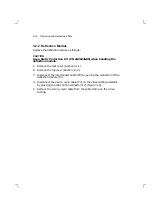
2–2
Troubleshooting
2.2 Troubleshooting Procedures
These procedures assume that only one assembly has failed or only one
problem exists. Always troubleshoot the most obvious symptom first.
However, one symptom may indicate multiple failures. Problems may
come from either the host system or the monitor.
Troubleshoot the VR319 monitor as follows:
1.
Ask the operator to describe the problem. The operator often is the
most knowledgeable person.
2.
Identify the problem. The screen display often indicates which
problem is occurring.
3.
Isolate the problem. Refer to the troubleshooting tables to find the
suggested solutions.
4.
Display the host system alignment test patterns to make sure that
no other problem exists. Refer to the host system service guide for
displaying test patterns.
2.3 Troubleshooting Tables
The troubleshooting tables list possible causes in order of probability.
This troubleshooting information applies to three types of video problems
that the VR319 monitor may exhibit:
•
A blank screen, without video or raster (Table 2–1)
•
A blank screen, without video, but raster present (Table 2–2)
•
Poor display quality (Table 2–3)
Use the troubleshooting tables as follows:
1.
Note the symptom of the problem.
2.
Check the Symptom column for a match.
3.
Check the conditions in the Possible Cause column in the order given.
4.
Perform the action in the Suggested Solution column in the order
given.













































